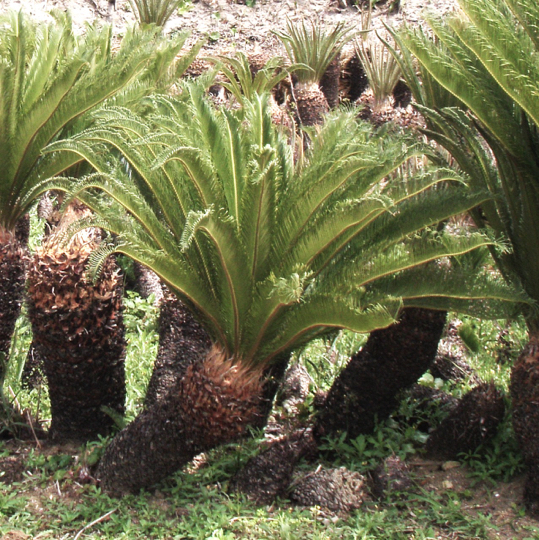Plant signals trigger remarkable bacterial transformation
Research Press Release | April 23, 2019
Cycad plant roots release signals into the soil that triggers the transformation of bacteria into its motile form, helping them move to the plant roots and establish a symbiotic partnership.

A group of sago cycad plants (Cycas revoluta). (Hashidoko Y. et al., Isolation and characterization of 1-palmitoyl-2-linoleoyl-sn-glycerol as a hormogonium-inducing factor (HIF) from the coralloid roots of Cycas revoluta (Cycadaceae), Scientific Reports, March 18, 2019.)
The cycad Cycas revoluta is a palm-like plant that grows on rocky coastal cliffs in the sub-tropics and tropics. It has a symbiotic relationship with the Nostoc species of bacteria that can convert nitrogen from the atmosphere into ammonia, which the host plant can then use for its growth. Scientists knew that cycad roots produce a compound that can induce Nostoc species within the soil to transform into their motile form, hormogonia, and attracting them to the roots. However, nobody has determined what exactly the compound is.
In the current study published in the journal Scientific Reports, agricultural chemist Yasuyuki Hashidoko and colleagues at Hokkaido University investigated an extract made from the “coralloid roots” of C. revoluta plants. These are specialized roots that branch out from the plant’s main root system.
They found that the extract was able to trigger the transformation of Nostoc bacteria into hormogonia. Further analyses revealed the main active elements present in the extract were a mixture of diacylglycerols; typical compounds contained in plants that are composed of two fatty acid chains linked together.
The team tested each of the diacylglycerols for their abilities to act as hormogonia-inducing factors (HIF), and found that 1-palmitoyl-2-linoleoyl-sn-glycerol showed pronounced HIF-like activity on the bacteria. The investigations also enabled the researchers to theorize which specific changes to fatty acid chain segments led to the compounds having more, less, or no HIF-like activity.

Cyanobacteria which have undergone induced differentiation into filamentous hormogonia. The cells at the tip (arrows) are known to have a strong relation to hormogonia’s motility. Copyright Yasuyuki Hashidoko, Hokkaido University.
“These findings appear to indicate that some common diacylglycerols act as hormogonium-inducing signal for Nostoc cyanobacteria, enabling them to move and transfer to host plants,” the researchers conclude. “Since the bacteria can provide host plants nitrogen to help them grow, better understanding of the system could someday lead to more efficient, less fertilizer-dependent agricultural production.”
Original article:
Hashidoko Y. et al., Isolation and characterization of 1-palmitoyl-2-linoleoyl-sn-glycerol as a hormogonium-inducing factor (HIF) from the coralloid roots of Cycas revoluta (Cycadaceae), Scientific Reports, March 18, 2019.
DOI: 10.1038/s41598-019-39647-8
Funding information:
This work was supported by Grants-in-aid for Scientific Research A and B from the Japan Society for the Promotion of Science (grant numbers 26252058 and 26304042 to Yasuyuki Hashidoko).
Contacts:
Professor Yasuyuki Hashidoko
Research Faculty of Agriculture,
Hokkaido University
Email: yasu-h[at]abs.agr.hokudai.ac.jp
Tyler Tannert (International Public Relations Specialist)
Institute for International Collaboration
Public Relations Division
Hokkaido University
Tel: +81-11-706-2186
Email: en-press[at]general.hokudai.ac.jp

